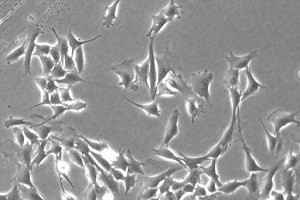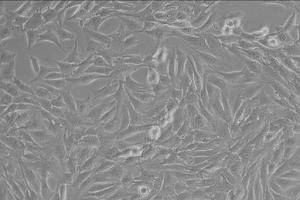Cell line profile C2C12
(ECACC catalogue no. 91031101)
Cell line history
C2C12 is a subclone from a myoblast line established from normal adult C3H mouse leg muscle1. The original cell line, C2, was obtained by Yaffe and Saxel in 1977 by establishing primary cultures from the thigh muscle of 2 month old normal mice, 70 hours after crush injury2.


24 hours post resuscitation Prior to cryopreservation
Key characteristics
Differentiates rapidly; produces extensive contracting myotubes, expressing characteristic muscle proteins. Recombinant bone morphogenetic protein-2 (BMP-2) has been shown to inhibit the formation of multinucleated myotubes formed by confluent C2C12 cells, which in turn leads to the shift of the differentiation pathway of the cells from a myoblastic lineage to an osteoblastic lineage3.
Applications
C2C12 is one of the most popular cell lines supplied by ECACC. These cells provide in vitro models to study differentiation of myoblasts and osteoblasts and mechanistic biochemical pathways. C2C12 cells have also been used to aid the understanding of early myogenesis by identifying the underlying regulatory network performed by transcriptional regulators, using profiling and shRNA screens4. Due to their high division rate, C2C12 cells are useful in studying the cell cycle. For example, the mechanism of X inactivation, via the highly coordinated replication of Xi in early S-phase of the cell cycle, was studied in C2C12 cells using GFP-tagged replication proteins and BrdU-labelled nucleotides5.
Culture tips
C2C12 cells should be cultured in DMEM + 2mM Glutamine + 10-15% Foetal Bovine Serum (FBS). Cells can be relatively slow growing when resuscitated from frozen taking 4-5 days to reach 50% confluence when seeded at 2x1,000 cells/cm² . Split semi-confluent cultures (50 - 70%) 1:3 to 1:6 i.e. seeding at 1-2x1,000 cells/cm² using 0.05% trypsin or trypsin/EDTA; 5% CO2; 37°C. Do not allow cells to reach confluence as myotube formation may occur.
|
Similar cell lines |
ECACC catalogue number |
Description |
|---|---|---|
|
G-7 |
Mouse Swiss-Webster myoblast |
|
|
G-8 |
Mouse Swiss-Webster myoblast |
Key references
1. Blau H et al. Plasticity of the differentiated state. Science 230(4727): 758-766, 1985.
2. Yaffe D and Saxel O. Serial passaging and differentiation of myogenic cells isolated from dystrophic mouse muscle. Nature 270: 725-727, 1977.
3. Katagiri T, et al. Bone morphogenetic protein-2 converts the differentiation pathway of C2C12 myoblasts into the osteoblast lineage J. Cell Biol. 127: 1755-1766, 1994.
4. Rajan S, et al. Analysis of early C2C12 myogenesis identifies stably and differentially expressed transcriptional regulators whose knock-down inhibits myoblast differentiation. Physiol Genomics 44(2): 183-197, 2012.
5. Casas-Delucchi C et al. Histone acetylation controls the inactive X chromosome replication dynamics. Nat Coms. 2: 222, 2011.
